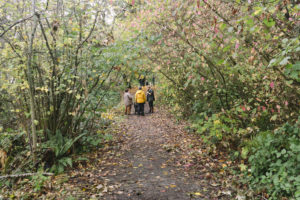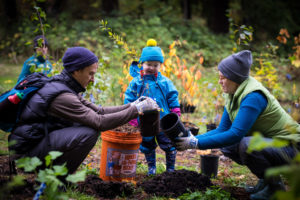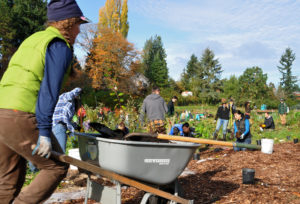Benefits of Parklands
The Green Seattle Partnership is an ambitious effort to restore all 2,500 acres of Seattle’s forested parkland by 2025. It will not be easy in this rapidly developing landscape, but if we are successful, we will leave a legacy of a truly emerald city.
Why undertake this grand task? Healthy forests offer tremendous benefits for cities and those who inhabit them. Here’s how:
Healthy Environment
Water
 It rains a lot in Seattle. While the region’s native vegetation is well adapted to the frequent precipitation, asphalt and concrete are not. When rainwater washes over these impervious surfaces, it picks up the pollutants we leave behind – from oil to dog waste to heavy metals – and deposits them in your local waterbody.
It rains a lot in Seattle. While the region’s native vegetation is well adapted to the frequent precipitation, asphalt and concrete are not. When rainwater washes over these impervious surfaces, it picks up the pollutants we leave behind – from oil to dog waste to heavy metals – and deposits them in your local waterbody.
Trees and pervious natural areas intercept the filthy runoff. They hold rainwater and filter it slowly through their soils, simultaneously keeping our waterways clean and reducing flood hazards. Seattle Public Utilities calculates that these stormwater benefits from the city’s forest are worth $1 million annually.
Air
Trees trap particulate pollution, such as asthma-inducing diesel soot, and reduce airborne ozone, nitrogen dioxide, and sulfur dioxide. In a city teeming with cars and industrial areas, trees are crucial in improving the air we breathe.
More fundamentally, trees produce the very air we breathe. They absorb carbon dioxide and emit oxygen, forming a symbiotic relationship with humans and other animals. As is well known, fossil fuel combustion is throwing off that balance; we need trees now more than ever to absorb carbon and combat climate change. One acre of forest can absorb as much carbon dioxide in a year as a car emits in driving 26,000 miles.
Healthy People
In addition to cleaning the air and water that sustain us, forested parks directly improve human health and wellbeing. For one, forests are home to a buffet of immune-boosting microorganisms shown to reduce allergies and promote digestive health. They also encourage recreation and exercise, which are vital to long-term health and happiness. Especially for those lacking the time or resources to venture into the surrounding wilderness, having nearby natural areas vastly improves quality of life. City parks are many peoples’ first contact with the outdoors, and can spark in them a lifelong connection with the natural world.
Studies show that forests also provide significant psychological benefits. As Kathleen Wolf and others have documented, nearby nature reduces stress and depression, enhances focus and memory, and even promotes financial and academic success.
Strong Communities
 Parks are vital “third places” in our urban communities. They provide public space where people can connect with nature and one another. Volunteer restoration efforts build on this community function. Work parties bring neighbors together from all walks of life as they work toward the common goal of greening the city.
Parks are vital “third places” in our urban communities. They provide public space where people can connect with nature and one another. Volunteer restoration efforts build on this community function. Work parties bring neighbors together from all walks of life as they work toward the common goal of greening the city.
And contrary to the saying, sometimes money does grow on trees. Forested parks boost adjacent property values an average of 15 percent, while nearby nature can increase customer spending in business districts and significantly reduce crime.
Problem and Solution
We cannot, however, take these benefits for granted. Seattle’s forested parklands face serious challenges as the region continues to grow. Deforestation from 1972 to 1996 cost the city $1.3 million per year in rainwater storage and $226,000 per year in air pollution-related health care costs – we must ensure that this does not happen again.
Chief among today’s risks is the proliferation of invasive species. Non-native plants such as Himalayan blackberry and English ivy wreak havoc on Seattle’s forests, outcompeting native plants and preventing young trees from establishing themselves. If we do nothing, the next generation’s urban forest will be a treeless tangle that offers few of the benefits discussed above.
 Fortunately, we will not do nothing. Through robust volunteer programming and professional monitoring and stewardship, Green Seattle Partnership is bringing Seattle’s forests to their full glory. By weeding, mulching, and planting, we are maintaining the immense benefits that our natural infrastructure provides – and having lots of fun in the process. If every Seattle resident volunteered just three times a year, we would be able to care for every acre of forested parkland in the city.
Fortunately, we will not do nothing. Through robust volunteer programming and professional monitoring and stewardship, Green Seattle Partnership is bringing Seattle’s forests to their full glory. By weeding, mulching, and planting, we are maintaining the immense benefits that our natural infrastructure provides – and having lots of fun in the process. If every Seattle resident volunteered just three times a year, we would be able to care for every acre of forested parkland in the city.
Get started today! Volunteer at one of our many events around the city.
Connect with Us
